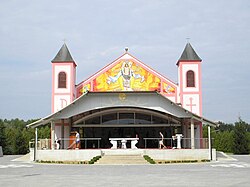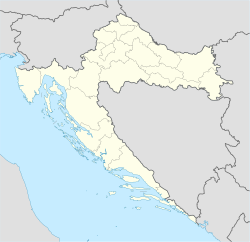Ludbreg
Ludbreg is a town in Croatia, located halfway between Varaždin and Koprivnica near the river Drava. It has 3,603 inhabitants, and a total of 8,478 in the entire municipality (census 2011).[4] History For centuries Ludbreg has been a popular place of pilgrimage. In 1320 the city was mentioned for the first time as Castrum Ludbreg, when owned by Hungarian noble Nicholas Ludbregi. The name of the town comes probably from a crusader named Lobring, who founded the settlement. The renovated Castle of Batthyány is home to a well-known restoration workshop. Ludbreg is also a region of vineyard cultivation (especially Riesling and Graševina).[5] The town gained fame after the eucharistic miracle, which happened in the castle chapel in 1411 and was investigated and confirmed by Pope Leo X in 1513.[citation needed] In the late 19th and early 20th century, Ludbreg was a district capital in Varaždin County of the Kingdom of Croatia-Slavonia.[citation needed] On 24 April 1932, the town saw a protest that was one of the earliest open acts of resistance against the 6 January Dictatorship.[6] ClimateSince records began in 1981, the highest temperature recorded at the local weather station was 38.2 °C (100.8 °F), on 24 August 2012.[7] The coldest temperature was −26.6 °C (−15.9 °F), on 8 January 1985.[8] MunicipalityThe following settlements comprise the Ludberg municipality:[4][9]
PopulationTown of Ludbreg: Population trends 1857–2021
Notable people
References
External linksWikimedia Commons has media related to Ludbreg.
|
||||||||||||||||||||||||||||||||||||||||||||||||||||||||||||||||||||||||||||||||||






















